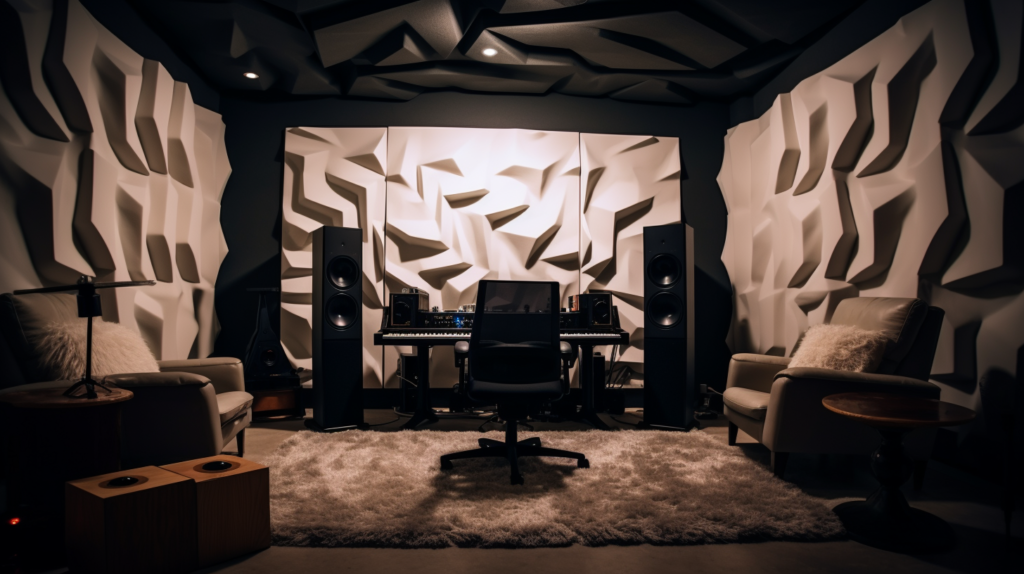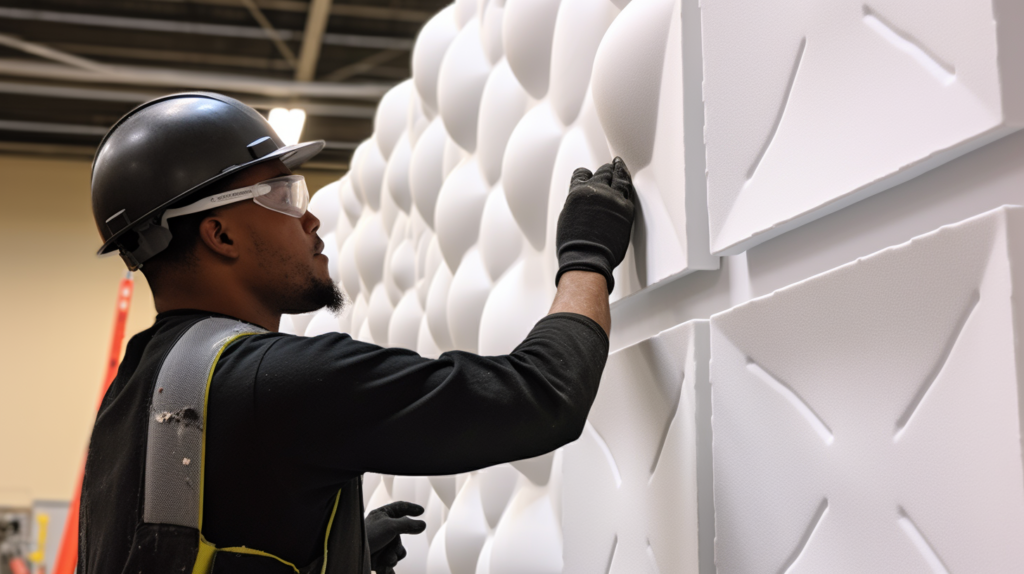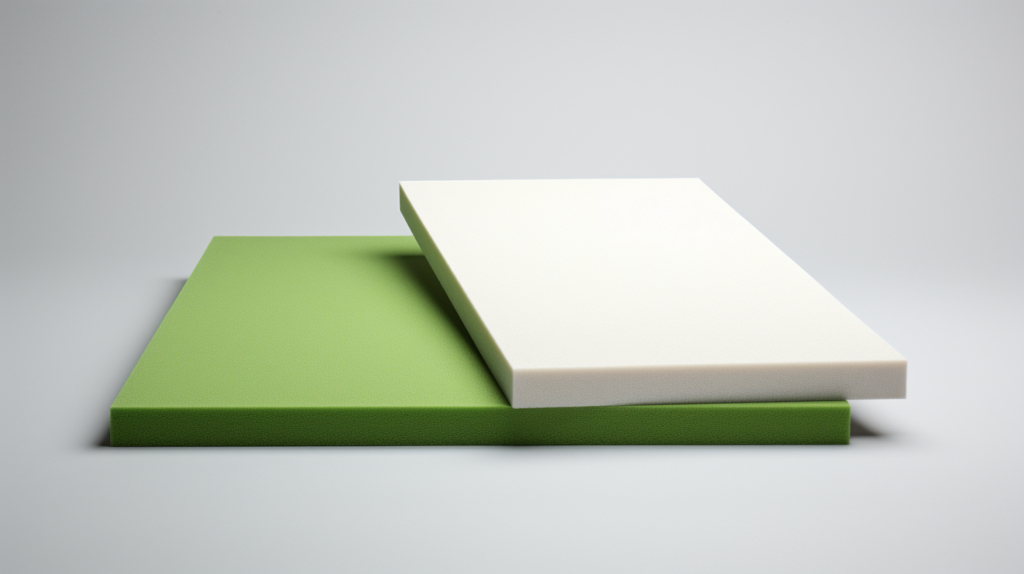Picture this: You’ve invested in top-notch recording equipment for your home studio, only to find that your recordings are tainted with echoes, unwanted reverb, androles of acoustic foam distracting background noise.
The culprit? Poor room acoustics.
In the realm of home studios, where the quality of sound capture is paramount, acoustic foam serves as an indispensable tool for optimizing your space.
However, understanding the roles of acoustic foam—and how it differs from other solutions like polyester acoustic panels—is crucial for achieving the best sound quality.
Let’s dive into the nuances of acoustic foam, its applications in home studios, and how it compares with other materials.
Why Is Room Acoustics Important?

When it comes to the subject of room acoustics, most people automatically conjure images of grandiose concert halls, professional recording studios, or hi-fi home theater systems.
However, the real importance of room acoustics is much more pervasive and extends well beyond these specialized environments.
Acoustics and Everyday Life
Before diving into specific use-cases like home studios, it’s crucial to understand that room acoustics touch nearly every aspect of our lives.
The subtleties of a well-strummed guitar, the emotive voice of an actor, or even the delicate timbre of a grand piano can all be greatly affected by the room’s acoustic characteristics.
Even more everyday situations, like watching a movie at home, attending a lecture, or participating in a Zoom call, are heavily impacted by the quality of the room’s acoustics.
The Impact on Quality of Experience
Imagine watching a critically acclaimed movie with muffled dialogues or listening to a beloved symphony with a constant echo in the background.
Poor acoustics can diminish the emotional impact and overall experience.
This becomes even more critical in professional settings like home studios, where the subtleties of sound can make or break a recording.
The Business and Educational Consequence
In business settings like conference rooms and office spaces, poor acoustics can impede clear communication, leading to misunderstandings and decreased productivity.
In educational institutions, students could miss crucial parts of a lecture due to echoing halls or ambient noise.
Therefore, the significance of acoustics isn’t just about fidelity to the original sound but is deeply linked to effective communication and the overall quality of experience.
What Factors Should You Consider Before Installing Acoustic Foam in Your Home Studio?

Room Architecture: A Starting Point
A lot of people think installing acoustic foam is as simple as sticking some panels to a wall. That couldn’t be further from the truth.
A room’s architecture is a primary factor that determines how sound waves will behave.
From the shape of the room—be it square, rectangular, or some other geometry—to the materials used in its construction, every architectural aspect plays a crucial role in acoustic performance.
If you’re setting up a home studio, you need to evaluate your room’s dimensions and shapes critically.
A rectangular room will have different acoustic characteristics from a square or circular one.
You’ll also need to consider the placement of windows, doors, and even furniture, as these can interact with sound waves in specific ways.
The Importance of Sound Source Identification
In any room, especially a home studio, knowing where the primary sound sources will be is pivotal.
The placement of microphones, instruments, or speakers will affect how sound waves interact with the room’s surfaces.
Failing to identify these sources could lead to ineffective acoustic treatment, costing you both time and money.
For example, in a home studio setting, it’s not uncommon for the space to serve multiple roles—perhaps it’s a mixing area and a recording space.
In such cases, you’ll need to balance the acoustic needs of both functions, requiring an understanding of different sound sources.
The Room’s Purpose and Acoustic Requirements
Every room has a purpose, and this is particularly true for specialized environments like home studios, theaters, or conference rooms.
Understanding the specific acoustic needs of a room is key to choosing the right materials and approaches for acoustic treatment.
For instance, if your home studio doubles as a mixing and recording space, your acoustic needs may differ than if it were solely a place for voice-over work.
Mixing may require deadening the room entirely to avoid any coloration of sound, while voice-over work may benefit from some natural room ambience.
In the case of a home studio for recording and mixing, you’ll likely need to control sound reflection, diffusion, and absorption to a greater extent than in a regular living space.
Being clear about the room’s purpose will guide you in selecting the right types and quantities of acoustic foam.
Where Are The Key Areas To Install Acoustic Foam In A Room?

Acoustic treatment isn’t merely about placing some foam on walls; it’s a nuanced process that requires a thoughtful approach.
Ignoring specific areas of your room can lead to inadequate treatment and unsatisfactory results.
The Troublesome Corners
Corners are a notorious haven for standing waves, which are essentially sound waves that reinforce or cancel each other out due to reflections from walls.
articularly in rectangular or square rooms, these corners can be a hotbed for low-frequency buildup. It’s often advisable to place bass traps in these areas.
Bass traps, made of denser material, are effective at soaking up these lower frequencies, thereby providing a more balanced sound within the room.
Treating corners is particularly critical in home studios where low-frequency accuracy is essential for tasks like mixing or mastering.
Ceiling Considerations
Many overlook the ceiling when planning acoustic treatment, but sound waves aren’t as discriminatory; they will bounce in all directions, including upwards.
Depending on the height of your ceiling, this could be a critical area for treatment.
Placing foam panels on the ceiling can absorb sound waves that would otherwise reflect back into the room, causing phase issues or muddy sound.
For home studios, where the quality of recordings is paramount, this is an area that should not be ignored.
Walls and First Reflection Points
Another key area for acoustic treatment is the walls, particularly those closest to your sound sources.
In any sound-sensitive environment like a home studio, sound waves emanate from speakers or instruments and hit the nearest wall surfaces.
These are known as ‘first reflection points.’
Identifying and treating these points with acoustic foam will absorb a significant amount of sound energy, reducing the chances of reflections corrupting your sound quality.
Techniques for Acoustic Foam Installation

Proper installation of acoustic foam is essential to ensure its effectiveness. Even the best material can’t function well if it’s improperly installed. Here are some points to consider:
Adhesive Choices
The adhesive you choose can have long-term implications on the foam’s integrity and its adhesive bond to the wall.
Some types of spray adhesives are easier to use, but it’s crucial to verify that they are compatible with your particular foam.
Check the manufacturer’s guidelines to ensure that the adhesive won’t break down the foam over time or affect its acoustic properties.
Panel Alignment and Gapping
If you’ve invested in high-quality acoustic foam, the last thing you’d want is to compromise its effectiveness through improper installation.
Gaps between foam panels or between the foam and the wall can significantly reduce the foam’s ability to absorb sound waves.
Before installation, map out your wall area, mark exact locations, and measure at least twice to confirm alignment.
Health and Safety Considerations
While acoustic foam is generally safe, it’s advisable to take some precautions during installation.
Always wear appropriate safety gear like gloves and masks when using adhesives, and ensure the room is well-ventilated.
Some foams may also emit a smell when freshly unpacked, so allowing time for off-gassing in a well-ventilated space is advisable.
Briefly, What’s The Difference Between Acoustic Foam And Acoustic Panels

While both acoustic foam and acoustic panels aim to improve a room’s sound quality, they do so in different ways and are suited for different types of environments.
Material Differences
Acoustic foam is usually made from polyurethane, which excels in absorbing high-frequency sound waves.
This makes it highly effective for reducing echoes and background noise, especially in smaller rooms or home studios.
On the other hand, acoustic panels come in a variety of materials, including wood, fabric, and polyester.
These panels are not only versatile in their aesthetic appeal but can also serve multiple functions like sound absorption, diffusion, and even blocking to some extent.
Suitability for Various Settings
Acoustic foam tends to be used primarily in spaces where aesthetic considerations are secondary to acoustic performance.
It’s often considered less visually pleasing, making it less suitable for office spaces or public areas.
Acoustic panels, with their range of materials and designs, can be tailored to fit the aesthetics of a room.
For example, polyester acoustic panels can be an excellent fit for modern office spaces, offering both functionality and visual appeal.
How Effective Are Polyester Acoustic Panels Compared To Acoustic Foam?

Polyester acoustic panels have emerged as a reliable alternative to traditional acoustic treatment options.
They offer a unique blend of properties that make them a versatile choice for a wide array of settings.
Durability Factor
Polyester is known for its durability, making it a long-lasting solution for acoustic treatment.
Unlike foam, which may degrade over time, especially when exposed to certain adhesives, polyester panels are robust and can withstand the test of time.
Moisture Resistance
In environments where moisture is a concern, such as indoor swimming pools or basements, polyester acoustic panels have a significant advantage.
Their resistance to moisture prevents the growth of mold and mildew, thereby ensuring a healthy environment along with acoustic control.
Wide Frequency Absorption
Polyester acoustic panels are effective across a broad spectrum of frequencies.
This makes them a preferred choice for multipurpose rooms or spaces with varied acoustic requirements.
Their ability to absorb a wide range of sound frequencies ensures that they can deliver a balanced acoustic environment, suitable for different types of audio activities.
Conclusion
In conclusion, acoustic foam and polyester acoustic panels are both invaluable tools in achieving optimal room acoustics.
Whether you’re setting up a recording studio, improving your home theater, or even making your office more conducive to productivity, understanding the role and function of these materials is crucial.
While acoustic foam is an excellent choice for sound absorption, particularly for higher frequencies, polyester acoustic panels offer durability, moisture resistance, and the versatility to address a wide range of acoustic needs.
Both types of acoustic treatment serve distinct but complementary roles, with each having its own set of considerations for installation and safety.
Regardless of your room’s purpose, paying attention to its acoustic properties can have a profound impact on the quality of sound and, by extension, the quality of experiences had in that space.
Therefore, investing in acoustic foam or polyester acoustic panels is not just about enhancing sound; it’s about enhancing lives.
